Numerical Study of Thermal Enhancement in a Single- and Double-Layer Microchannel Heat Sink with Different Ribs
Abstract
:1. Introduction
2. Description of Physical Models
3. Computational Method and Procedure
3.1. Mathematical Model
- Three-dimensional, steady-state, incompressible, laminar flow.
- Ignore gravity and thermal radiation heat transfer.
- Adopt inviscid dissipation
3.2. Boundary Conditions
3.3. Mesh Independence and Model Validation
3.4. Experiment and Simulation Verification
4. Results and Discussion
4.1. Influence of Rib Length
4.2. Influence of Rib Thickness and Angle
4.3. Overall Thermal Performance
5. Conclusions
- The existence of built-in ribs makes the fluid in the microchannel alternate between single and double layers, which can effectively enhance the heat transfer of the rectangular microchannel heat sinks.
- In four groups of rectangular ribbed plates with different lengths, the Nusselt number of Case 3 is 29.9% higher than that of Case 0, and the thermal resistance is 23.6% lower. The comprehensive evaluation coefficient of Case 2 is the highest, 3.57% higher than that of Case 4.
- Among the four groups of rectangular rib plates with different angles, the change of angle has little influence, but in terms of thickness, the change rate of the comprehensive evaluation factor is the largest, and the pump power is also the largest.
Author Contributions
Funding
Data Availability Statement
Conflicts of Interest
Nomenclature
| A_w | the heat transfer area |
| A_b | the area of the bottom surface |
| C_p | specific heat capacity |
| D_h | the hydraulic diameter |
| f | friction coefficient |
| h | heat transfer coefficient |
| M | the mass flow |
| Nu | Nusselt number |
| P | pressure in the flow field |
| Δp | pressure drop |
| q | the wall heat flux |
| Q | the total heat |
| R_th | total thermal resistance |
| Re | Reynolds number |
| T | temperature |
| T_”in” | the inlet temperature |
| T_s | the temperature of solid region |
| T_max | the maximum substrate temperature |
| ΔT_m | the mean temperature difference |
| V | the inlet velocity |
| u_i | velocity components in direction i |
| u_j | velocity components in direction j |
| x_i | cartesian coordinate components |
| x_j | cartesian coordinate components |
| ρ | density |
| λ_f | thermal conductivity of liquid region |
| λ_s | the thermal conductivity of the solid region |
| μ_f | Dynamic viscosity of base fluid |
References
- Hassan, I.; Phutthavong, P.; Abdelgawad, M. Microchannel heat sinks: An overview of the state-of-the-art. Microscale Thermophys. Eng. 2004, 8, 183–205. [Google Scholar] [CrossRef]
- Sidik, N.A.C.; Muhamad, M.N.A.W.; Japar, W.M.A.A.; Rasid, Z.A. An overview of passive techniques for heat transfer augmentation in microchannel heat sink. Int. Commun. Heat Mass 2017, 88, 74–83. [Google Scholar] [CrossRef]
- Tuckerman, D.B.; Pease, R. High-performance heat sinking for VLSI. IEEE Electron Device Lett. 1981, 2, 126–129. [Google Scholar] [CrossRef]
- Kadam, S.T.; Kumar, R. Twenty first century cooling solution: Microchannel heat sinks. Int. J. Therm. Sci. 2014, 85, 73–92. [Google Scholar] [CrossRef]
- Garimella, S.V.; Singhal, V.; Liu, D. On-chip thermal management with microchannel heat sinks and integrated micropumps. Proc. IEEE 2006, 94, 1534–1548. [Google Scholar] [CrossRef]
- Lee, P.S.; Garimella, S.V.; Liu, D. Investigation of heat transfer in rectangular microchannels. Int. J. Heat Mass Tran. 2005, 48, 1688–1704. [Google Scholar] [CrossRef] [Green Version]
- Husain, A.; Kim, K.Y. Thermal Optimization of a Microchannel Heat Sink with Trapezoidal Cross Section. J. Electron. Pack. 2009, 31, 021005. [Google Scholar] [CrossRef]
- Kumar, P. Numerical investigation of fluid flow and heat transfer in a trapezoidal microchannel with groove structure. Int. J. Therm. Sci. 2019, 136, 33–43. [Google Scholar] [CrossRef]
- Chai, L.; Xia, G.; Qi, J. Experimental and Numerical Study of Flow and Heat Transfer in Trapezoidal Microchannels. Heat Transfer Eng. 2012, 33, 972–981. [Google Scholar] [CrossRef]
- Belhocine, A.; Abdullah, O.I. Numerical simulation of thermally developing turbulent flow through a cylindrical tube. Int. J. Adv. Manuf. Technol. 2019, 102, 2001–2012. [Google Scholar] [CrossRef]
- Tokgoz, N. Experimental and numerical investigation of flow structure in a cylindrical corrugated channel. Int. J. Mech. Sci. 2019, 157, 787–801. [Google Scholar] [CrossRef]
- Wang, G.; Niu, D.; Xie, F.; Wang, Y.; Zhao, X.; Ding, G. Experimental and numerical investigation of a microchannel heat sink (MCHS) with micro-scale ribs and grooves for chip cooling. Appl. Therm. Eng. 2015, 85, 61–70. [Google Scholar] [CrossRef]
- Yang, W.; Xue, S.; He, Y.; Li, W. Experimental study on the heat transfer characteristics of high blockage ribs channel. Exp. Therm. Fluid Sci. 2017, 83, 248–259. [Google Scholar] [CrossRef]
- Li, Y.F.; Xia, G.D.; Ma, D.D. Characteristics of laminar flow and heat transfer in microchannel heat sink with triangular cavities and rectangular ribs. Int. J. Heat Mass Transf. 2016, 98, 17–28. [Google Scholar] [CrossRef]
- Xie, G.; Zhang, F.; Sundén, B.; Zhang, W. Constructal design and thermal analysis of microchannel heat sinks with multistage bifurcations in single-phase liquid flow. Appl. Therm. Eng. 2014, 62, 791–802. [Google Scholar] [CrossRef]
- Sarlak, A.; Ahmadpour, A.; Hajmohammadi, M.R. Thermal design improvement of a double-layered microchannel heat sink by using multi-walled carbon nanotube nanofluids with non-Newtonian viscosity. Appl. Therm. Eng. 2018, 147, 205–215. [Google Scholar] [CrossRef]
- Ansari, D.; Kim, K.-Y. Performance Analysis of Double-Layer Microchannel Heat Sinks under Non-Uniform Heating Conditions with Random Hotspots. Micromachines 2017, 8, 54. [Google Scholar] [CrossRef] [Green Version]
- Xie, G.; Li, Y.; Zhang, F.; Sundén, B. Analysis of micro-channel heat sinks with rectangular-shaped flow obstructions. Numer. Heat Transf. Part A Appl. 2016, 69, 335–351. [Google Scholar] [CrossRef]
- Leng, C.; Wang, X.D.; Wang, T.H. An improved design of double-layered microchannel heat sink with truncated top channels. Appl. Therm. Eng. 2015, 79, 54–62. [Google Scholar] [CrossRef]
- Shen, H.; Wang, C.C.; Xie, G. A parametric study on thermal performance of microchannel heat sinks with internally vertical bifurcations in laminar liquid flow. Int. J. Heat Mass Tran. 2018, 117, 487–497. [Google Scholar] [CrossRef]
- Cao, X.; Liu, H.L.; Shao, X.D. Heat transfer performance of a novel multi-baffle-type heat sink. Entropy 2018, 20, 979. [Google Scholar] [CrossRef] [PubMed] [Green Version]
- Wang, R.; Wang, J.; Yuan, W. Analysis and optimization of a microchannel heat sink with V-Ribs using nanofluids for micro solar cells. Micromachines 2019, 10, 620. [Google Scholar] [CrossRef] [PubMed] [Green Version]
- Chai, L.; Xia, G.D.; Wang, H.S. Numerical study of laminar flow and heat transfer in microchannel heat sink with offset ribs on sidewalls. Appl. Therm. Eng. 2016, 92, 32–41. [Google Scholar] [CrossRef]
- Derakhshanpour, K.; Kamali, R.; Eslami, M. Improving performance of single and double-layered microchannel heat sinks by cylindrical ribs: A numerical investigation of geometric parameters. Int. Commun. Heat Mass. 2021, 126, 105440. [Google Scholar] [CrossRef]
- Zhang, Y.D.; Chen, M.R.; Wu, J.H.; Hung, K.S.; Wang, C.C. Performance improvement of a double-layer microchannel heat sink via novel fin geometry—A numerical study. Energies 2021, 14, 3585. [Google Scholar] [CrossRef]
- Xu, M.; Lu, H.; Gong, L.; Chai, J.C.; Duan, X. Parametric numerical study of the flow and heat transfer in a microchannel with dimples. Int. Commun. Heat Mass. 2016, 76, 348–357. [Google Scholar] [CrossRef] [Green Version]
- Cao, X.; Liu, H.L.; Shao, X.D.; Shen, H.; Xie, G. Thermal performance of double serpentine minichannel heat sinks: Effects of inlet-outlet arrangements and through-holes. Int. J. Heat Mass Tran. 2020, 153, 119575. [Google Scholar] [CrossRef]
- Zhang, X.; Wang, Y.; Jia, R.; Wan, R. Investigation on heat transfer and flow characteristics of heat exchangers with different trapezoidal ducts. Int. Commun. Heat Mass. 2017, 110, 863–872. [Google Scholar] [CrossRef]
- Wu, H.Y.; Cheng, P. An experimental study of convective heat transfer in silicon microchannels with different surface conditions. Int. J. Heat Mass Tran. 2003, 46, 2547–2556. [Google Scholar] [CrossRef]
- Ho, C.J.; Wei, L.C.; Li, Z.W. An experimental investigation of forced convective cooling performance of a microchannel heat sink with Al2O3/water nanofluid. Appl. Therm. Eng. 2010, 30, 96–103. [Google Scholar] [CrossRef]
- Bhandari, P.; Prajapati, Y.K. Influences of tip clearance on flow and heat transfer characterstics of open type micro pin fin heat sink. Int. J. Therm. Sci. 2022, 179, 107714. [Google Scholar] [CrossRef]
- Bhandari, P. Numerical investigations on the effect of multi-dimensional stepness in open micro pin fin heat sink using single phase liquid fluid flow. Int. Commun. Heat Mass Transf. 2022, 138, 106392. [Google Scholar] [CrossRef]
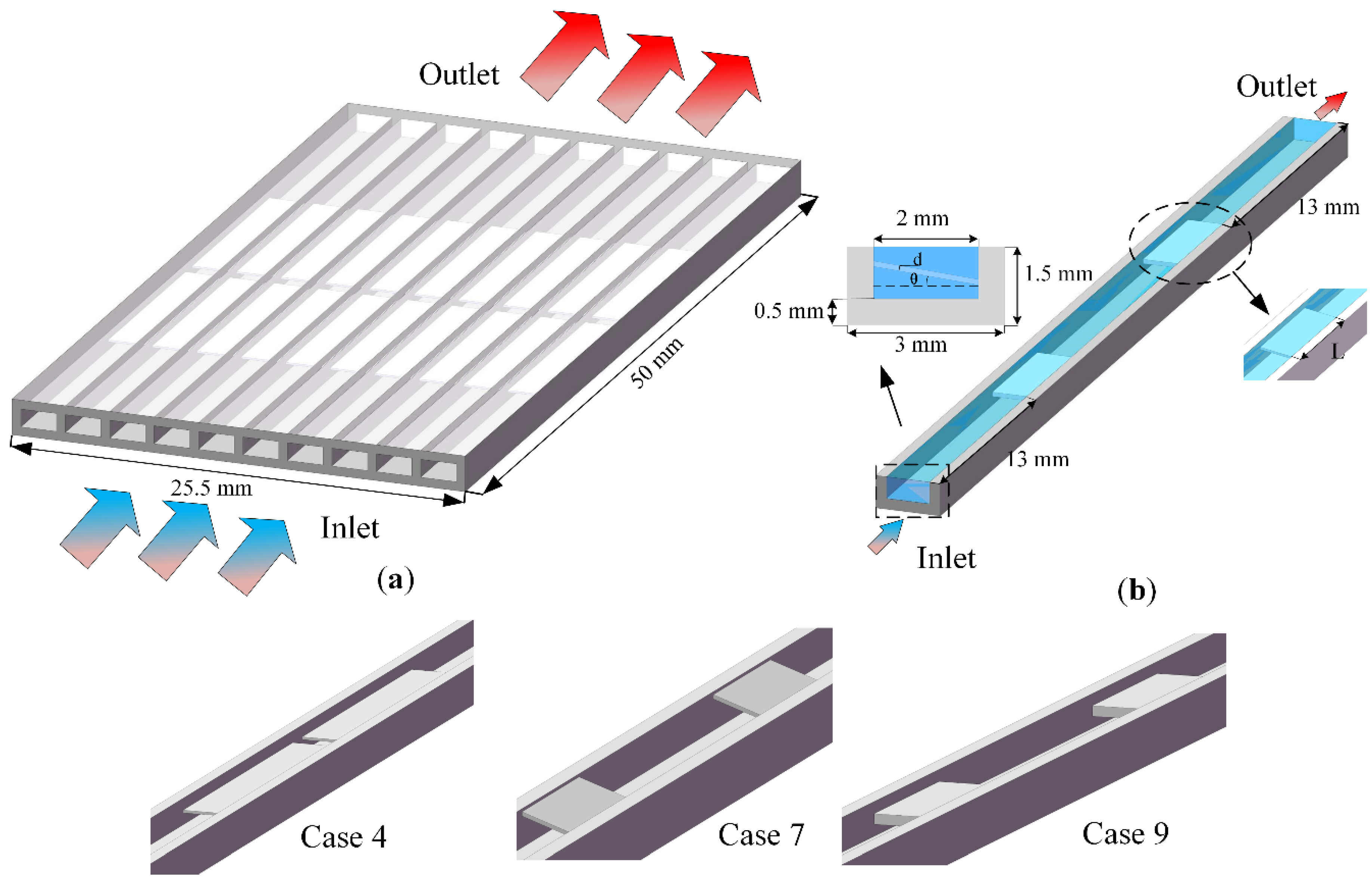
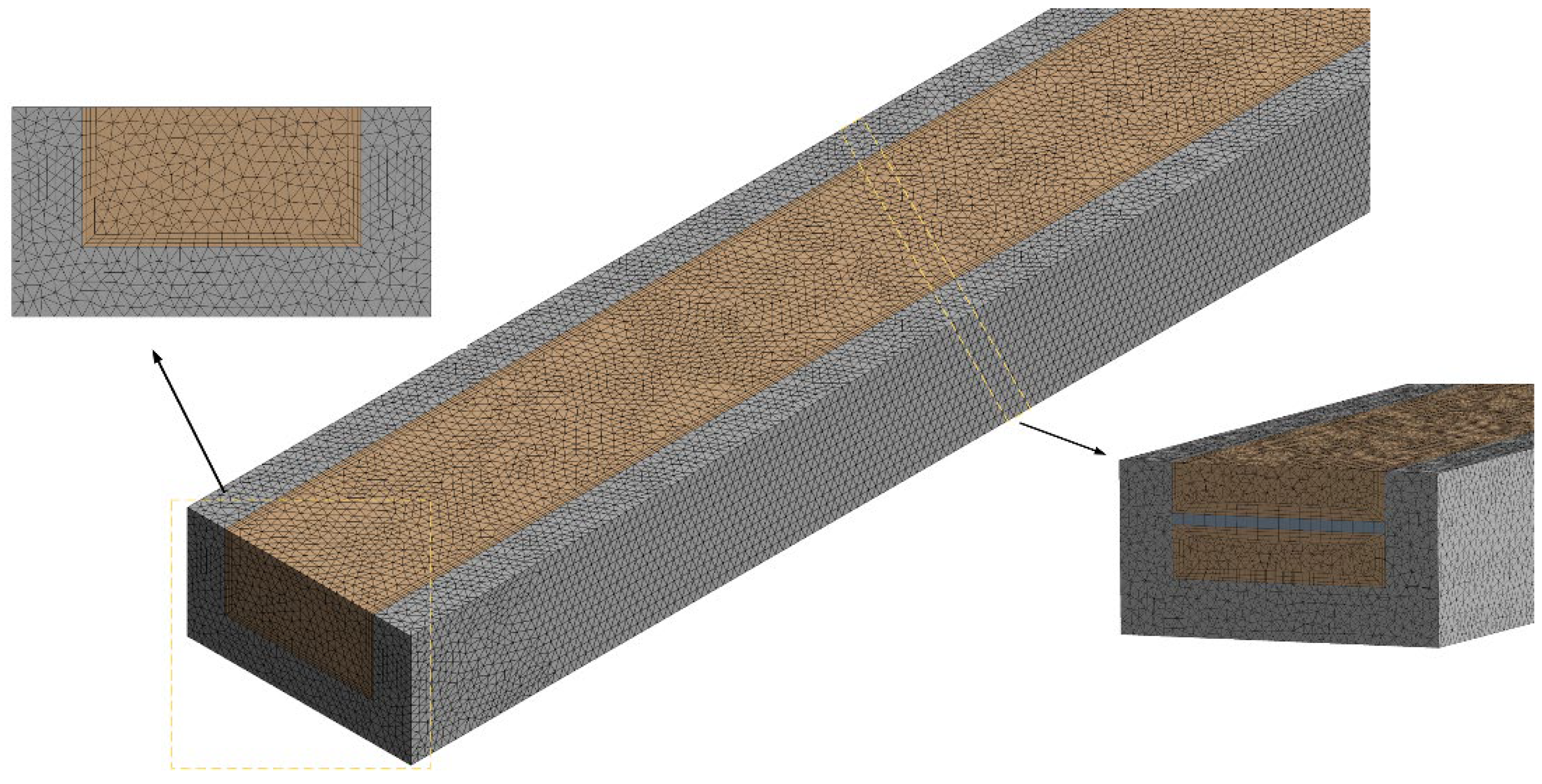
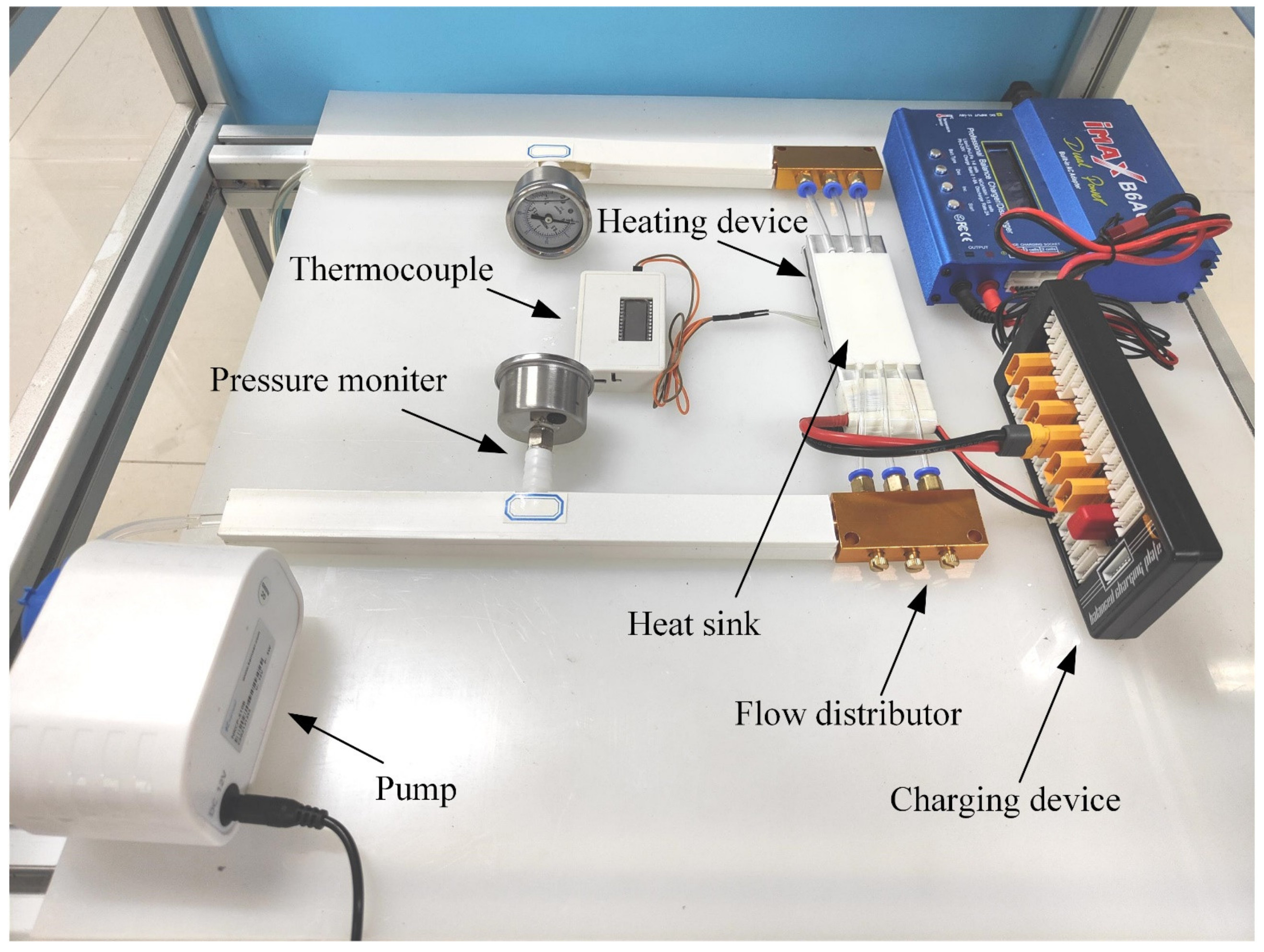
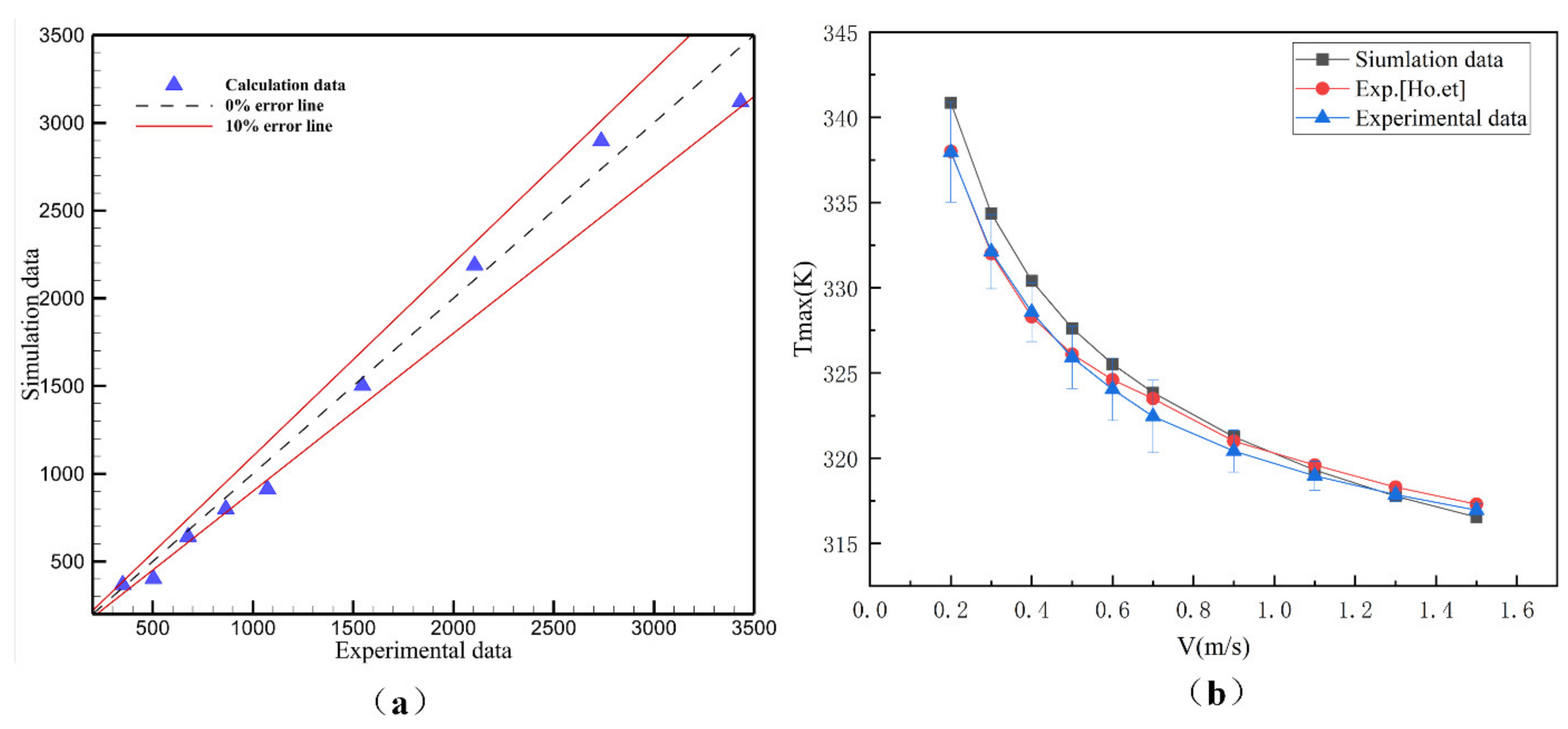
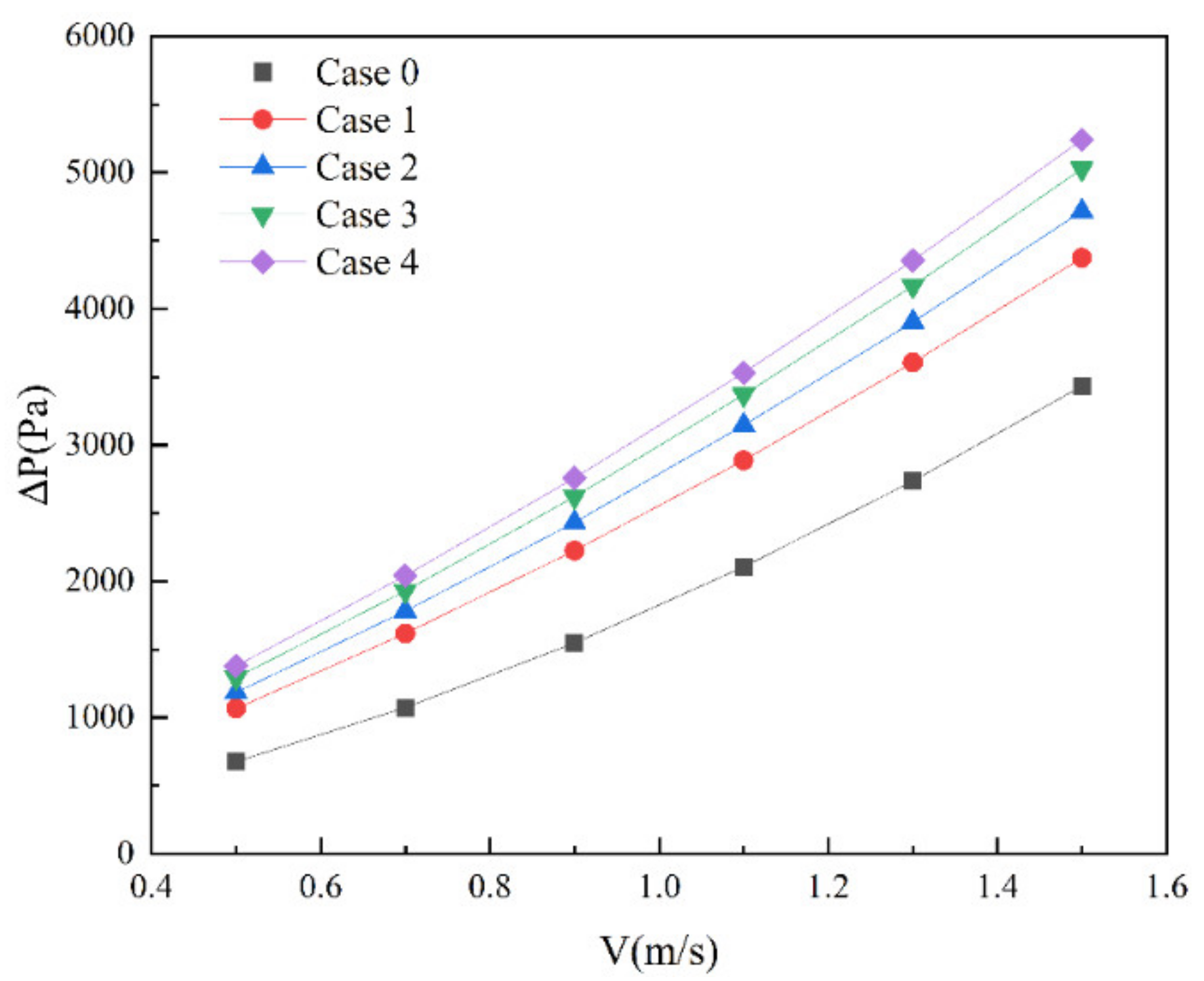
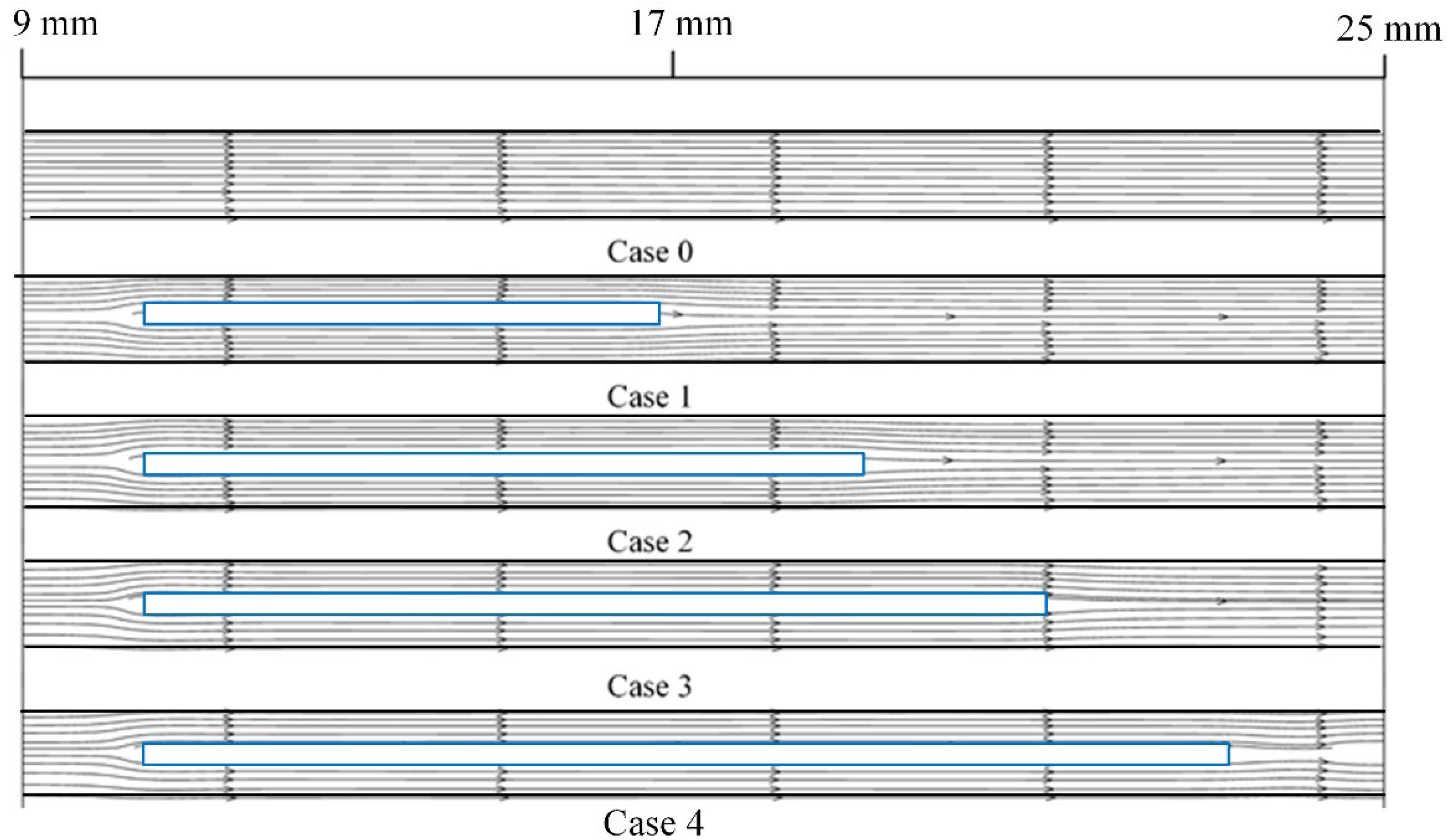

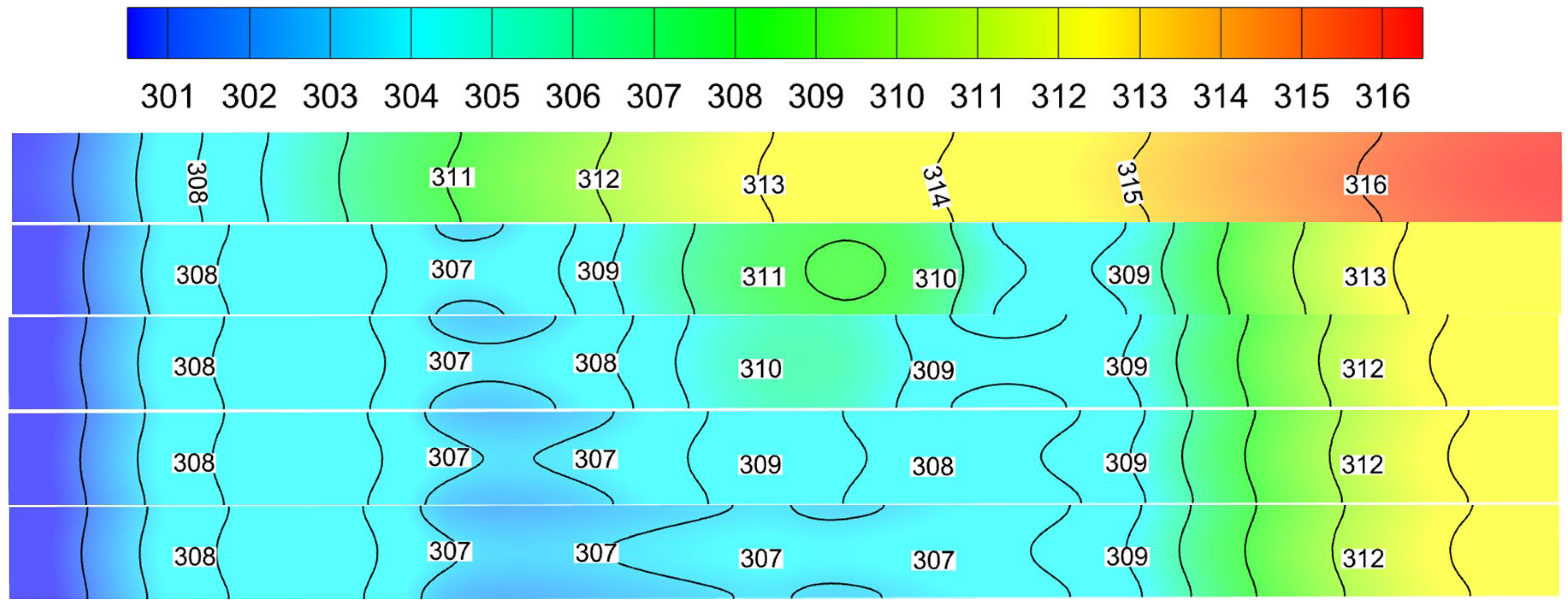
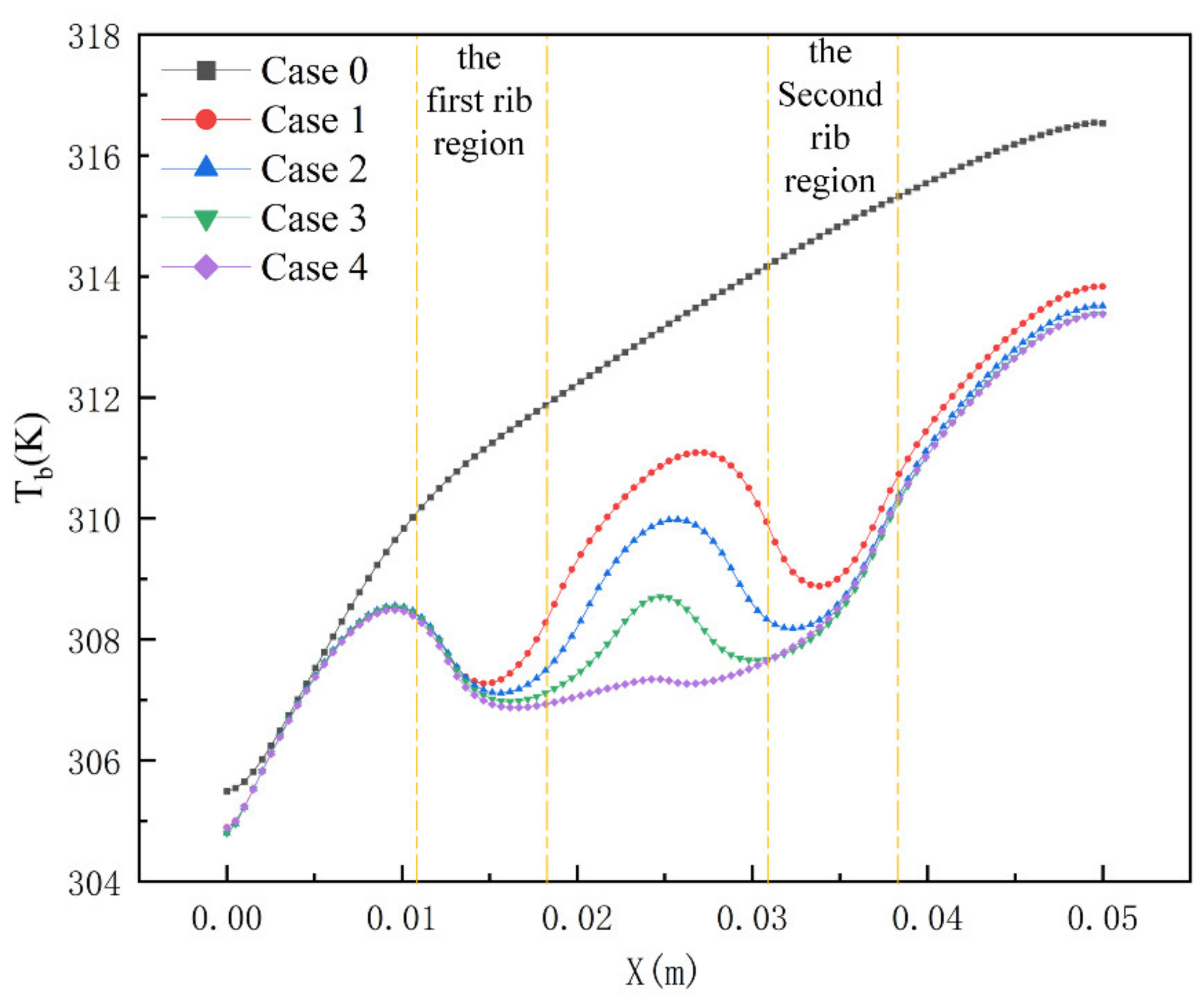


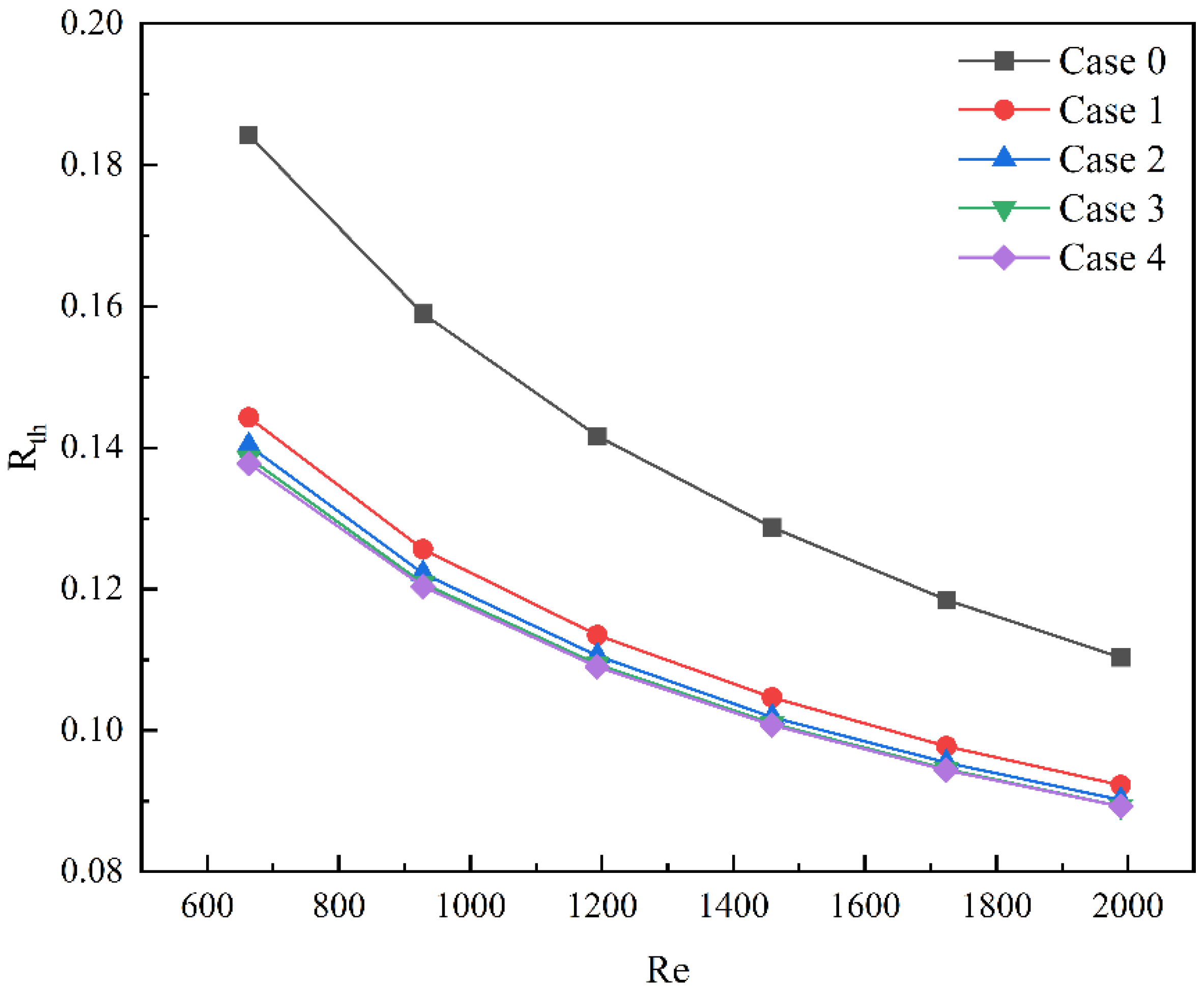
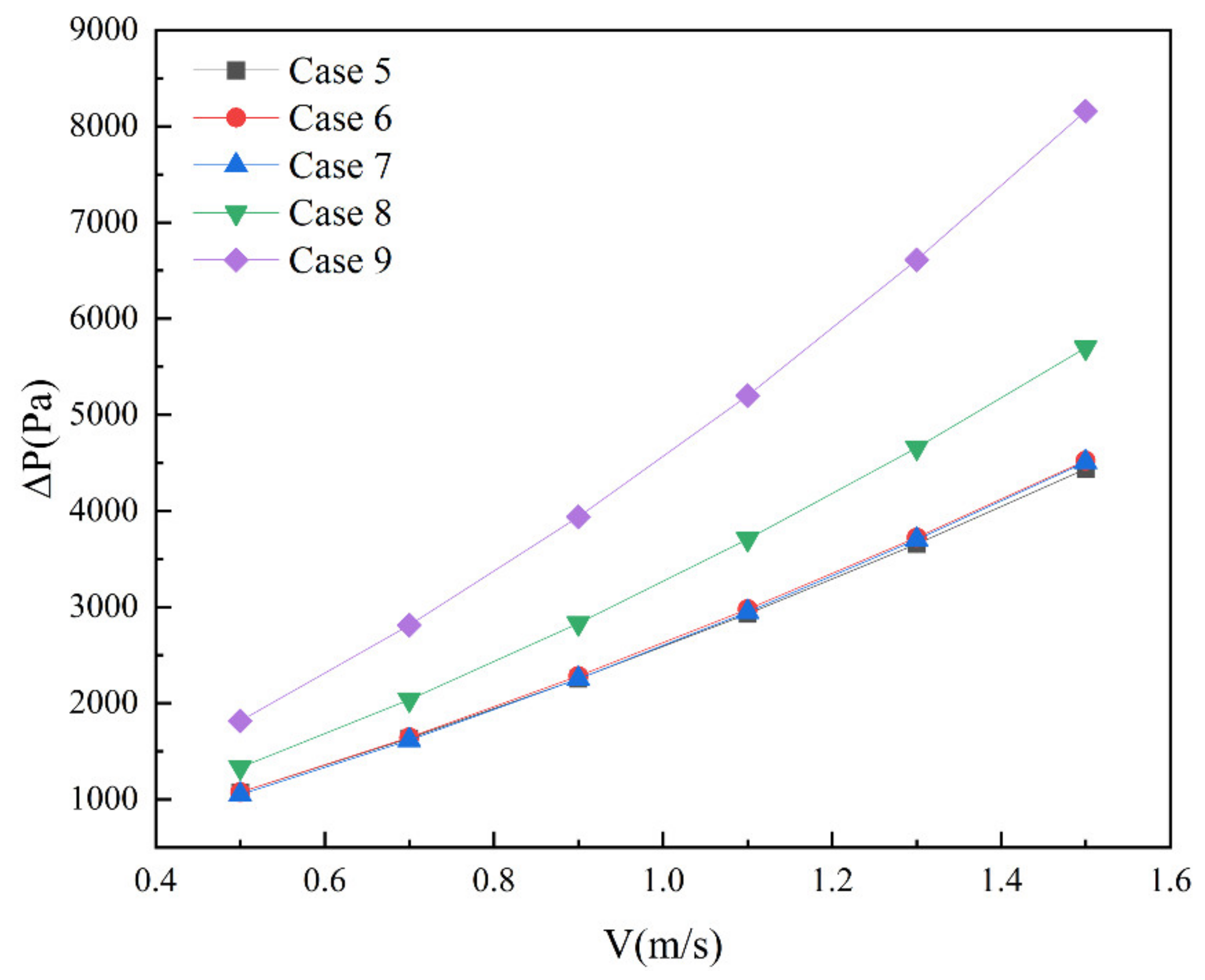
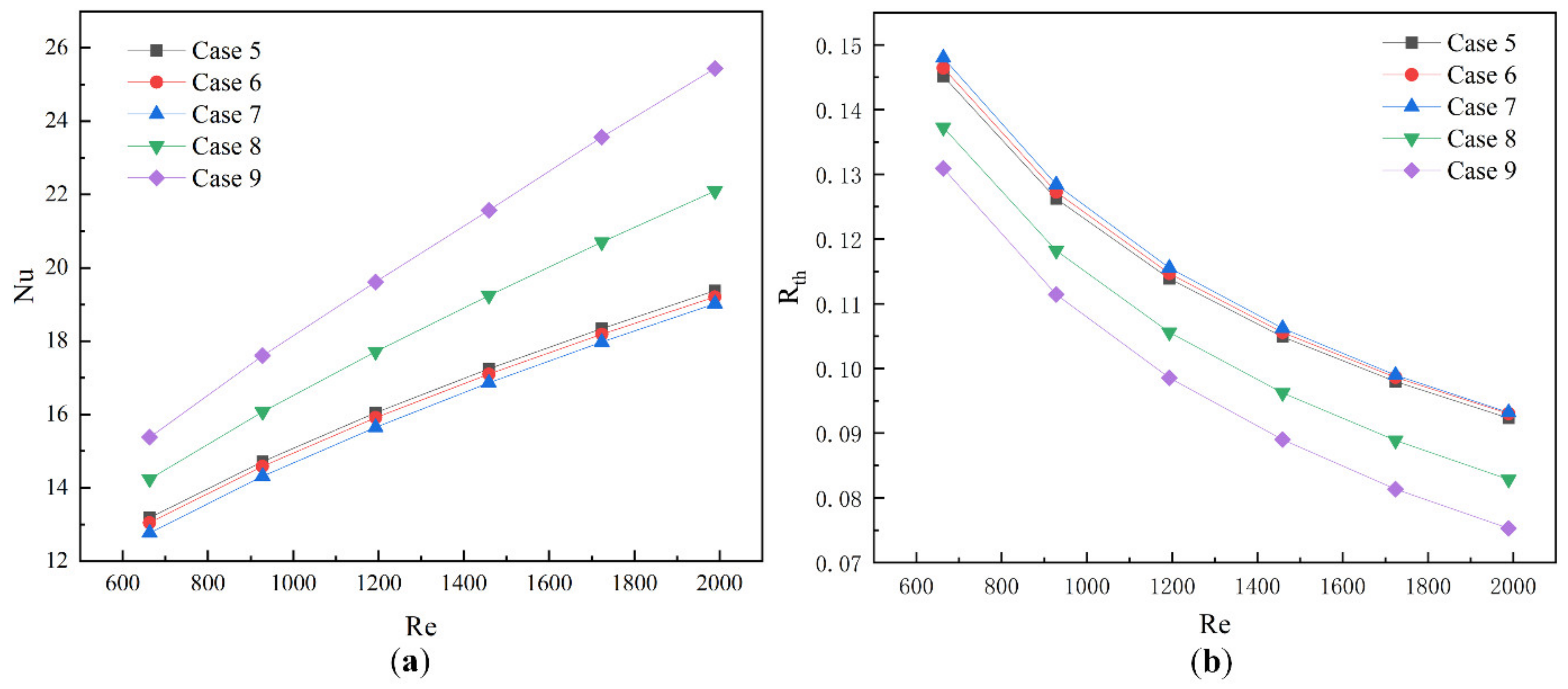

| Model | L (mm) | θ (°) | d (mm) |
|---|---|---|---|
| Case 1 | 5.5 | 0 | 0.1 |
| Case 2 | 7.5 | 0 | 0.1 |
| Case 3 | 9.5 | 0 | 0.1 |
| Case 4 | 11.5 | 0 | 0.1 |
| Case 5 | 5.5 | 10 | 0.1 |
| Case 6 | 5.5 | 15 | 0.1 |
| Case 7 | 5.5 | 20 | 0.1 |
| Case 8 | 5.5 | 0 | 0.2 |
| Case 9 | 5.5 | 0 | 0.3 |
| Mesh I | Mesh II | Mesh III | |
|---|---|---|---|
| Number of Grids | 450,263 | 524,690 | 679,869 |
| Nu | 10.278 | 9.965 | 9.983 |
| Difference | 2.96% | 0.18% | Baseline |
Publisher’s Note: MDPI stays neutral with regard to jurisdictional claims in published maps and institutional affiliations. |
© 2022 by the authors. Licensee MDPI, Basel, Switzerland. This article is an open access article distributed under the terms and conditions of the Creative Commons Attribution (CC BY) license (https://creativecommons.org/licenses/by/4.0/).
Share and Cite
Cao, M.; Cao, S.; Zhao, J.; Zhu, J. Numerical Study of Thermal Enhancement in a Single- and Double-Layer Microchannel Heat Sink with Different Ribs. Micromachines 2022, 13, 1821. https://doi.org/10.3390/mi13111821
Cao M, Cao S, Zhao J, Zhu J. Numerical Study of Thermal Enhancement in a Single- and Double-Layer Microchannel Heat Sink with Different Ribs. Micromachines. 2022; 13(11):1821. https://doi.org/10.3390/mi13111821
Chicago/Turabian StyleCao, Miaolong, Shi Cao, Jincheng Zhao, and Jiayi Zhu. 2022. "Numerical Study of Thermal Enhancement in a Single- and Double-Layer Microchannel Heat Sink with Different Ribs" Micromachines 13, no. 11: 1821. https://doi.org/10.3390/mi13111821




